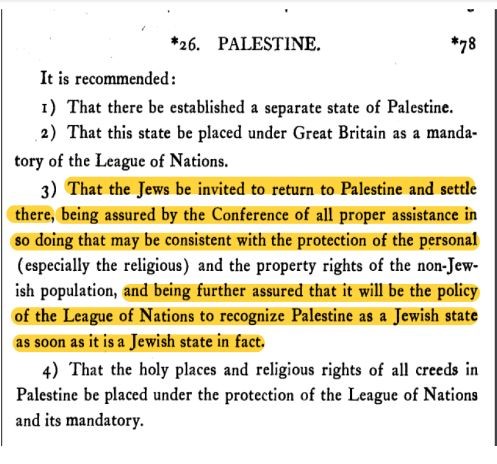
By: Maurice Hirsch, Adv. | May 15, 2023
Israeli diplomat and statesman Abba Eben once said of the United Nations, “If Algeria introduced a resolution declaring that the earth was flat and that Israel had flattened it, it would pass by a vote of 164 to 13 with 26 abstentions.” While Algeria has not yet declared the earth flat, an equivalent resolution, promoted by the Palestinians, did pass in the United Nations General Assembly (UNGA) in November 2022.
According to the resolution, the UN will mark the Palestinian “Nakba” on May 15, 2023 (today). The Arabic word “Nakba,” which means “catastrophe,” is the term used by the Palestinian Authority to describe the creation of the State of Israel. By adopting the Palestinian term, the UN is, in practice, denying Israel’s right to exist as a homeland for the Jewish people.
In its decision to adopt Palestinian propaganda, and equate the establishment of Israel with a “catastrophe”, the UNGA was actively participating in the Palestinian attempt to rewrite history.
Since the resolution reflects a basic ignorance of history and facts, in this report Palestinian Media Watch will present the essential facts that show that Israel was established in the realization of international consensus, and pursuant to repeated decisions adopted by the international community.
PMW will also show how many of the so-called “Palestinian refugees” fled Mandatory Palestine prior to the creation of the State of Israel, and that many of those who did flee, did so at the behest of the Arab armies.
Finally, and pertinently for the days following the war instigated by the Palestinian terrorists in Gaza, PMW will show that while Israel offered to incorporate Gaza into Israel and give all the Arabs living there Israeli citizenship, the offer was rejected by the Arab countries.
Israel’s exclusive legal title to the entire area from Lebanon in the north to the Red Sea in the south, from the Jordan River in the east to the Mediterranean Sea in the west
First and foremost, it is important to stress, that despite the propaganda efforts to invent history, no independent “State of Palestine” has ever existed.
While the Palestinians and their supporters in the UN constantly try to negate the historical fact, the truth of the matter is that on four different occasions, the world powers and the international community confirmed, and reconfirmed, the allocation of the entire area from Lebanon in the north to the Red Sea in the south, from the Jordan River in the east to the Mediterranean Sea in the west to the Jewish people for the purpose of “reconstituting their national homeland.” No such parallel decisions were made about creating an Arab “Palestine” within that area.
As history shows, from 1517 until 1917, the entire area of Israel, including Judea, Samaria and the Jordan valley was part of the Ottoman Empire. During this period, no independent sovereign state existed in the area. Rather, Palestine, home to Arabs and Jews, was merely part of the district of greater Syria.
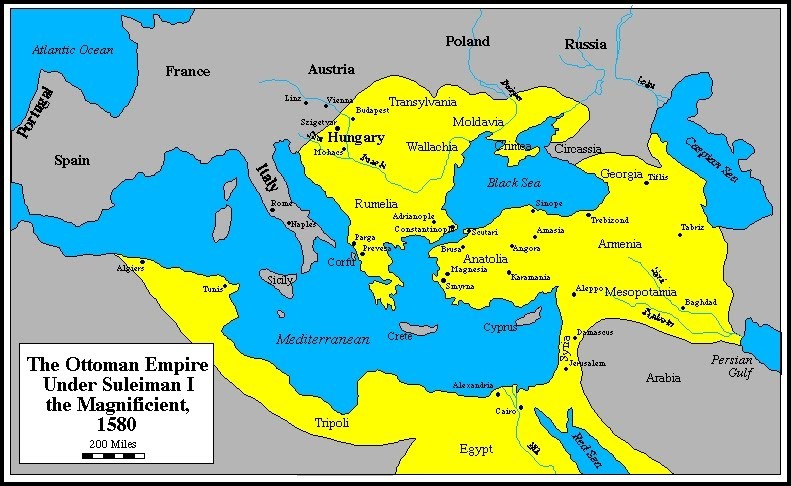
In 1916, anticipating the end of the WWI, representatives of the British and French empires made an agreement, with the concurrence of the Russian Empire, to divide control over the Middle East between them. The agreement, known as the “Sykes – Picot Agreement” divided the spheres of influence and control in much of the Middle East between the two empires according to the following map:
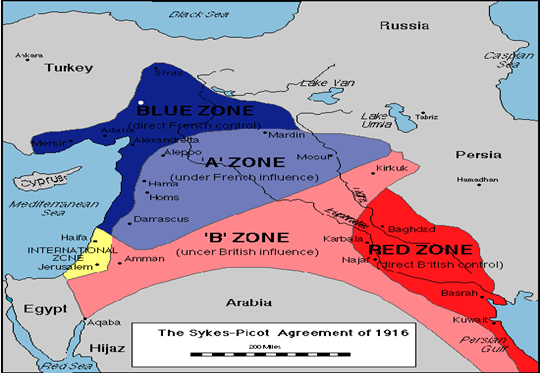
In 1917, the British government issued the Balfour Declaration:
“His Majesty’s Government view with favour the establishment in Palestine of a national home for the Jewish people, and will use their best endeavors to facilitate the achievement of this object, it being clearly understood that nothing shall be done which may prejudice the civil and religious rights of existing non-Jewish communities in Palestine or the rights and political status enjoyed by Jews in any other country.” [emphasis added]
In 1919, following the end of the First World War, the international community met at the Paris Peace Conference to decide how to divide the territories of the vanquished Ottoman empire.
One of the documents that reflect the sentiments of the time was the US “Outline of Tentative report and recommendations prepared by the Intelligence Section, in accordance with instructions, for the President and the plenipotentiaries” dated Jan. 21 1919, prepared for the conference. The document set out a vision to form both parts of Europe and the Middle East. Alongside the creation of many Arab countries, the document recommended creating, de novo, an independent state called “Palestine” which would be a “Jewish state”. No independent state called “Palestine” had ever existed previously:
“It is recommended:
1) That there be established a separate state of Palestine.
2) That this state be placed Under Great Britain as a mandatory of the League of Nations.
3) That the Jews be invited to return to Palestine and settle there being assured by the Conference of all proper assistance in so doing that may be consistent with the protection of the personal (especially the religious) and the property rights of the non-Jewish population. and being further assured that it will- be the policy of the League of Nations to recognize Palestine as a Jewish state as soon as it is a Jewish state in fact.
4) That the holy places and religious rights of all creeds in Palestine be placed under the protection of the League of Nations and its mandatory.
.[My Diary at the Conference of Paris, With Documents,
By David Hunter Miller, Volume IV, Documents 216-304]
The discussion of the recommendations added:
“The separation of the Palestinian area from Syria finds justification in the religious experience of mankind. The Jewish and Christian churches were born in Palestine, and Jerusalem was for long years, at different periods, the capital of each. And while the relation of the Mohammedans to Palestine is not so intimate, from the beginning they have regarded Jerusalem as a holy place. Only by establishing Palestine as a separate state can justice be done to these great facts.” …
It is right that Palestine should become a Jewish state, if the Jews, being given the full opportunity, make it such. It was the cradle and home of their vital race, which has made large spiritual contributions to mankind, and is the only land in which they can hope to find a home of their own; they being in this last respect unique among significant peoples.
At present, however, the Jews form barely a sixth of the total population of 700,000 in Palestine, and whether they are to form a majority, or even a plurality, of the population in the future state remains uncertain. Palestine, in short, is far from being a Jewish country now. England, as mandatory, can be relied on to give the Jews the privileged position they should have without sacrificing the rights of non-Jews.”
[My Diary at the Conference of Paris, With Documents,
By David Hunter Miller, Volume IV, Documents 216-304]
Meeting in again in April 1920, in San Remo, Italy, the principal allies who defeated the Germans and the Ottomans resolved that some areas would become states. As regards “Palestine”, the allies resolved:
“the Mandatory will be responsible for putting into effect the declaration originally made on the [2nd] November, 1917, by the British Government and adopted by the other Allied Powers, in favour of the establishment in Palestine of a national home for the Jewish people.”
At the time, “Palestine” was comprised of both Israel (including Judea, Samaria and the Jordan Valley) and the territory that is today Jordan.
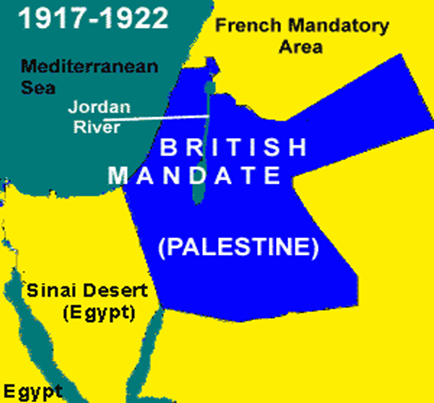
The San Remo resolution was entrenched in the 1922 League of Nations Mandate for Palestine.
The preamble to the Mandate reaffirmed the Balfour Declaration and once again confirmed the historical connection of the Jewish people to the Land of Israel by stating:
“Whereas the Principal Allied Powers have also agreed that the Mandatory should be responsible for putting into effect the declaration originally made on November 2nd, 1917, by the Government of His Britannic Majesty, and adopted by the said Powers, in favor of the establishment in Palestine of a national home for the Jewish people, it being clearly understood that nothing should be done which might prejudice the civil and religious rights of existing non-Jewish communities in Palestine, or the rights and political status enjoyed by Jews in any other country;
Whereas recognition has thereby been given to the historical connection of the Jewish people with Palestine and to the grounds for reconstituting their national home in that country.” [emphasis added]
In 1923, pursuant to Article 25 of the Mandate, a decision was made to divide Mandatory Palestine into two entities – “Palestine” that lay to the west of the Jordan river and “Trans-Jordan” which would in time (1946) be recognized as the Hashemite Kingdom of Jordan. The provisions of the Mandate for establishing the Jewish National Home, including through the settlement of Jews on the land, continued to apply in the entire area to the west of the Jordan river, which was a mere one third of the full Palestine designated for the Jewish state. The following map illustrates this division:

While Article 80 of the newly convened United Nations (which replaced the League of Nations) Charter preserved the rights of the Jewish people granted in the Mandate, in the aftermath of World War II, the UN again addressed the question of the Palestine. Having considered the different recommendations submitted, on November 29, 1947, the General Assembly of the UN adopted resolution 181, known as the “Palestine Partition Plan“. This resolution sought to further divide the remaining territory allocated for the Jewish state in Palestine into two new states – a Jewish state and an Arab state – setting the new boundaries of the nascent states, as can be seen in the following illustration:
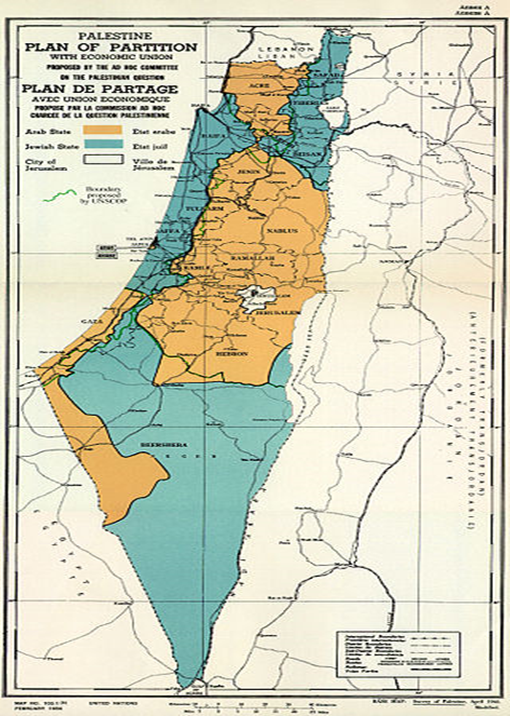
No reference to the term “The West Bank” appears in the UN Partition Plan. In fact, when delineating the boundaries of the “Arab State”, the resolution specifically refers to “The boundary of the hill country of Samaria and, Judea starts on the Jordan River”.
While the representatives of the Jewish People accepted the Partition Plan, the Arab representatives and the surrounding Arab countries rejected the plan in its entirety and started active preparations to seize the entire area by military force. The response of the Arab representatives and countries made implementation of UNGA Resolution 181 impossible and it was never confirmed by the UN Security Council.
On May 14 1948, Israel declared its Independence without specifying its borders. The new State was immediately attacked by a coalition of five Arab states as well as Arab forces in the former Mandate territory, who collectively strived to wipe it out. The Egyptian forces attacked from the south, the Lebanese and Syrian forces attacked from the north and the Jordanian forces, accompanied by Iraqi forces attacked from the east.
The Jordanian forces attacked and occupied Judea, Samaria and the Jordan Valley, calling them for the first time, “the West Bank”. The Jordanian forces and local Arab militias who occupied the area, destroyed the Jewish communities that existed, killing or expelling their residents. The massacre after they had surrendered of many of the 127 men and women who were killed defending Kibbutz Kfar Ezion in the hills of Judea, is one such example.
In 1949, Israel concluded “Armistice” agreements with the neighboring Arab countries. The armistice agreement with Jordan, provided that the demarcation lines drawn would under no circumstances be considered as “borders”.
Thus, Article II.2 of the armistice agreement stated:
“It is also recognised that no provision of this Agreement shall in any way prejudice the rights, claims and positions of either Party hereto in the ultimate peaceful settlement of the Palestine question, the provisions of this Agreement being dictated exclusively by military considerations”
Article VI.9 of the same agreement provided:
“The Armistice Demarcation Lines defined in articles V and VI of this Agreement are agreed upon by the Parties without prejudice to future territorial settlements or boundary lines or to claims of either Party relating thereto.”
The armistice lines would then become known as the “Green Line”.
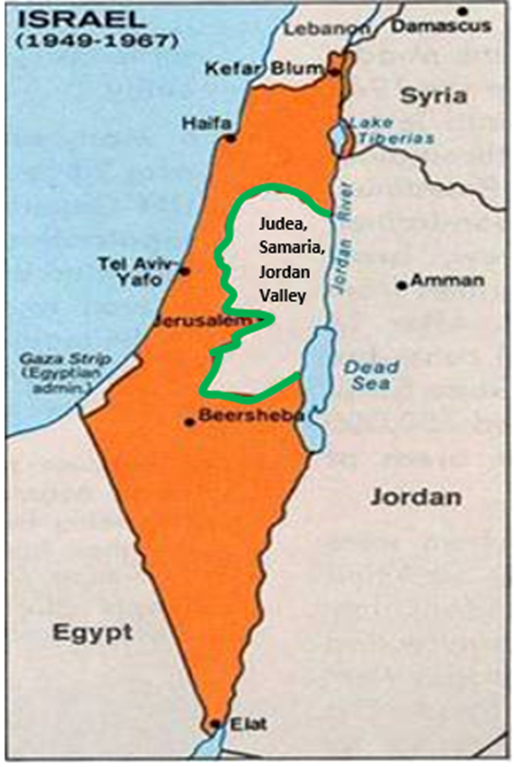
A Jordanian attempt to annex Judea, Samaria and the Jordan Valley was rejected by the international community.
Article 24 of the original 1965 Palestine Liberation organization (PLO) Charter provided that “This Organization [The PLO] does not exercise any territorial sovereignty over the West Bank in the Hashemite Kingdom of Jordan, on the Gaza Strip or in the Himmah Area”.
In June 1967, Jordan again attacked Israel. Defending itself against the attack, Israel expelled the Jordanian occupiers, and seized control of Judea, Samaria and the Jordan Valley.
Several months after the end of the Six day War, on November 22, 1967 the UN adopted resolution 242. This resolution, often erroneously cited as requiring Israel to retreat to the pre-1967 borders, in fact read as follows:
“The Security Council,
Expressing its continuing concern with the grave situation in the Middle East,
Emphasizing the inadmissibility of the acquisition of territory by war and the need to work for a just and lasting peace in which every State in the area can live in security,
Emphasizing further that all Member States in their acceptance of the Charter of the United Nations have undertaken a commitment to act in accordance with Article 2 of the Charter,
Affirms that the fulfillment of Charter principles requires the establishment of a just and lasting peace in the Middle East which should include the application of both the following principles:
1) Withdrawal of Israeli armed forces from territories occupied in the recent conflict;
2) Termination of all claims or states of belligerency and respect for and acknowledgement of the sovereignty, territorial integrity and political independence of every State in the area and their right to live in peace within secure and recognized boundaries free from threats or acts of force;
Affirms further the necessity
1) For guaranteeing freedom of navigation through international waterways in the area;
2) For achieving a just settlement of the refugee problem;
3) For guaranteeing the territorial inviolability and political independence of every State in the area, through measures including the establishment of demilitarized zones;
Requests the Secretary General to designate a Special Representative to proceed to the Middle East to establish and maintain contacts with the States concerned in order to promote agreement and assist efforts to achieve a peaceful and accepted settlement in accordance with the provisions and principles in this resolution;
Requests the Secretary-General to report to the Security Council on the progress of the efforts of the Special Representative as soon as possible.” [emphasis added]
Resolution 242 does not require Israel to withdraw from all “the territories occupied” but rather calls for a just and lasting peace which should include both withdrawal by Israel from “territories occupied” and “respect for and acknowledgement of the sovereignty, territorial integrity and political independence of every State in the area and their right to live in peace within secure and recognized boundaries free from threats or acts of force”.
While earlier drafts of the resolution had proposed withdrawal by Israel from “the territories occupied” the word “the” was removed from the final resolution as adopted by the Security Council so as to signify that a full withdrawal by Israel to the armistice lines established in 1949 would not be required.
As the above conclusively demonstrates, no “State of Palestine” ever existed, except for the express purpose of establishing the Jewish homeland. The “Nakba” that the UN will mark, is merely an attempt to retroactively invent the “State of Palestine” and to then claim that Israel was created in place of the non-existent state.
The so-called “Palestine refugees”
The “Palestine refugees” are defined by the United Nations Relief and Works Agency for Palestine Refugees (UNRWA) as people who fled Mandatory Palestine “during the period 1 June 1946 to 15 May 1948”.
While the PA and the UN attribute the exodus of the Arabs from Mandatory Palestine to Israel, it is clear that hundreds of thousands of Arabs left during the period of British Mandate, preceding the creation of the State of Israel.
As this PMW video documents with eyewitness testimony, there was a massive migration from Israel initiated by Arabs themselves who fled during the war, in response to the call of the Arab armies and other Arab leaders who were trying to eliminate Israel. The Arab armies and leaders called on their fellow Arabs to leave the area, promising that they would return shortly.
For example, testimonies of refugees, that can be seen in this PMW video compilation, include the following statements:
“Cars with megaphones roamed the streets, demanding that people leave” [Official PA TV, Oct. 2, 2014]
“The one who made us leave was the Jordanian army” [Official PA TV, May 15, 2013]
“The radio stations of the Arab regimes kept repeating to us: ‘Get away'” [Official PA TV, July 7, 2009]
“Our [Arab] district officer issued an order that whoever stays in Palestine is a traitor” [Official PA TV, April 30, 1999]
The Arab Salvation Army told the Palestinians: “We have come to you in order to exterminate the Zionists… Leave your houses and villages, you’ll return to them safely in a few days.” [Al-Ayyam, May 13, 2008]
“The Arab Salvation Army said: ‘Leave, but don’t go far from the village because they [the Jews] will make a short visit…’ The people left with nothing, even without bread.” [Al-Quds daily YouTube channel, May 17, 2016]
Having lost the war, and since they and the Arab countries refused to accept Israel’s existence, the refugees were not allowed to return.
In their belief that the refugees could be used as human pawns, the Arab countries, refuse to settle the refugees and their descendants, preferring to hold them in limbo for the last 75 years.
While UN documents prove that the Israeli leadership was willing to compromise on the subject of the refugees, the same documents demonstrate the Arab intransigence.
For example, the October 23, 1950 General Progress Report and Supplementary Report of the United Nations Conciliation Commission for Palestine, covering the period from 11 December 1949 to 23 October 1950 records how Israel proposed that the Armistice Lines be accepted as permanent borders and that in return for the incorporation of the Gaza Strip into Israel, “the Government of Israel would be prepared to accept as citizens of Israel the entire Arab population of the area, both inhabitants and refugees…”
In accordance with their unwillingness to accept Israel’s very existence, the Arab countries rejected the Israeli proposal.
As PMW has shown, for the PA, the demand that every one of the “Palestine refugees” – a group that grew from an estimated 711,000 originally to almost 6,000,000 today – be allowed to return to Israel, is just another expression of their goal to destroy Israel.
While the Palestinians bemoan the “Nakba” and place the blame on Israel, , in reality, it is the Arab countries who are responsible for the suffering of the Arab population. First by their rejection of Israel’s existence and trying to destroy Israel by war, second by telling the Arabs of Israel to flee which made them into refugees, and third by not giving the Arab refugees citizenship in their countries. This would have solved the so-called “refugee problem” and alleviated their suffering more than 70 years ago.

